Datong city wall
In my old Baedeker from 1912, the map of Beijing still shows the old city wall, which is also mentioned in the text as something worth visiting. Its remnants were pulled down in and around the 50s to make way for one of the ring roads around Beijing. Only a small fragment of it survives, at the southeastern corner. I hope to visit this in the not too distant future.
Most of the old city wall remains in Datong. It is in rather poor shape, but it is being restored. Here are some photos of an unrestored piece of it just north of Xiangjiang Xijie. I am fascinated by all those doors into the wall. This would be on the outside, so I doubt that they are original. People must have dug chambers into the wall.

This picture is from where the wall has been broken to make way for the street.
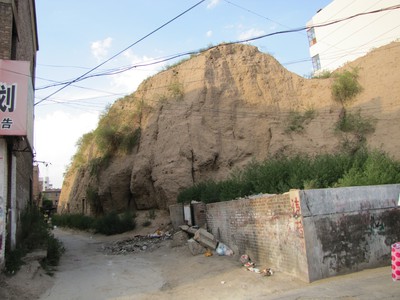
Also from the same place. At point just to the left of the top of the modern wall, I think one can see clearly that the wall was build in bricks.
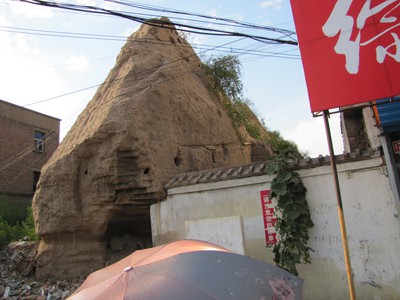
Later I spotted the wall towards the end of a back alley, so I walked down it, to find a garbage-strewn open place just inside the southwestern corner of the wall, and I got a closer look at the restoration works. At least from the inside I could not spot the tower that must once have defended this corner, but I have a feeling that it will be resurrected in the restoration.
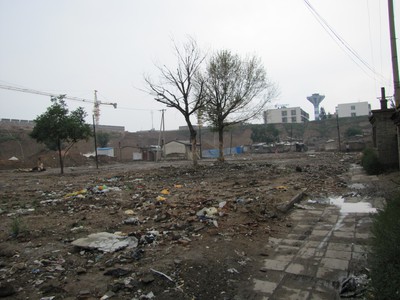
Zooming in, one can sort of see the outlines of the original bricks. I am sorry that I did not walk closer to get better pictures, but all the garbage and the puddles of that empty lot did not quite invite someone walking in sandals to get any further. Besides, there were three ragged wild dogs looking for food there. They showed no signs of being dangerous, indeed a couple of them ran past me, but still...
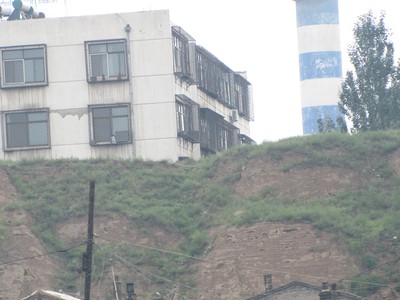
Here is a wooden watchtower being reconstructed.

You can guess at the method of reconstruction: A new surface of new bricks is built on the outside of the remnants of the original wall. Notice the long line of cranes for the reconstruction of the wall!
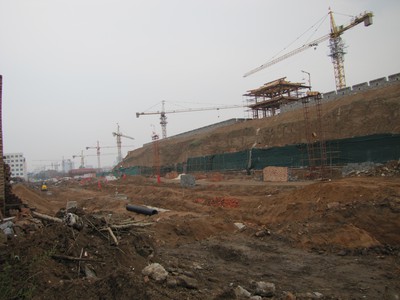
Another picture from the ongoing restoration works, this one from just south of the Southern monastery, next to what must have been the central southern gate.
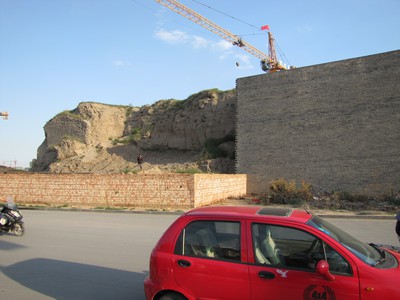
And finally some pictures from the almost finished restoration, on the east side of the city, at the eastern gate to which the Da Dongjie (Great Eastern Street) leads.

The great gate at the end of Da Dongjie.
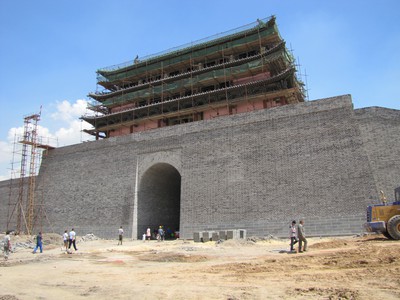
I walked in through the gate into a double barbicane.

Perhaps not constructed in the same way as the original.

My impression, but I am far from an expert, is that this restoration seems rather similar to those made by Viollet-Le-Duc in nineteenth-century France: to rebuild the remnants in the way they "must" have looked when they were new. I hope this kind of reconstruction in China is preceeded by careful documentation by professional archeologists of what actually is there. I wish this were so, but I saw no signs of such archeological work.
The results of the reconstruction are, nevertheless, breathtakingly impressive.
See also a reportage from the BBC.
Most of the old city wall remains in Datong. It is in rather poor shape, but it is being restored. Here are some photos of an unrestored piece of it just north of Xiangjiang Xijie. I am fascinated by all those doors into the wall. This would be on the outside, so I doubt that they are original. People must have dug chambers into the wall.

This picture is from where the wall has been broken to make way for the street.

Also from the same place. At point just to the left of the top of the modern wall, I think one can see clearly that the wall was build in bricks.

Later I spotted the wall towards the end of a back alley, so I walked down it, to find a garbage-strewn open place just inside the southwestern corner of the wall, and I got a closer look at the restoration works. At least from the inside I could not spot the tower that must once have defended this corner, but I have a feeling that it will be resurrected in the restoration.

Zooming in, one can sort of see the outlines of the original bricks. I am sorry that I did not walk closer to get better pictures, but all the garbage and the puddles of that empty lot did not quite invite someone walking in sandals to get any further. Besides, there were three ragged wild dogs looking for food there. They showed no signs of being dangerous, indeed a couple of them ran past me, but still...

Here is a wooden watchtower being reconstructed.

You can guess at the method of reconstruction: A new surface of new bricks is built on the outside of the remnants of the original wall. Notice the long line of cranes for the reconstruction of the wall!

Another picture from the ongoing restoration works, this one from just south of the Southern monastery, next to what must have been the central southern gate.

And finally some pictures from the almost finished restoration, on the east side of the city, at the eastern gate to which the Da Dongjie (Great Eastern Street) leads.

The great gate at the end of Da Dongjie.

I walked in through the gate into a double barbicane.

Perhaps not constructed in the same way as the original.

My impression, but I am far from an expert, is that this restoration seems rather similar to those made by Viollet-Le-Duc in nineteenth-century France: to rebuild the remnants in the way they "must" have looked when they were new. I hope this kind of reconstruction in China is preceeded by careful documentation by professional archeologists of what actually is there. I wish this were so, but I saw no signs of such archeological work.
The results of the reconstruction are, nevertheless, breathtakingly impressive.
See also a reportage from the BBC.
Kommentarer
Trackback
